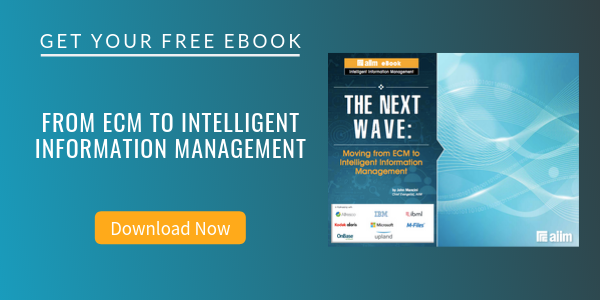
Information Logistics: The Weak Link in Your Supply Chain
Intelligent Information Management (IIM) | Logistics
Mention the word “logistics,” and odds are the person on the other end will conjure up images of some massive and complex military operation – and the challenge of reporting upon military logistics in some intelligent way.
“Logistics” also conjures up images of complicated supply chains, and the Rube Goldberg-esque complexities of summarizing, rationalizing, and reporting on them in an intelligent way.
.gif?width=428&height=302&name=Rube_Goldberg's_-Self-Operating_Napkin-_(cropped).gif)
In a modern digital organization, “Logistics” doesn’t just refer to the movement of people or physical objects. Organizations face complex information logistics challenges in coordinating all of the various unconnected content silos that have arisen over the past 15 years – and continue to multiply as more and more SaaS and consumer technologies are adopted by newly empowered line of business executives.
AIIM reports that 52% of organizations have three or more ECM/DM/RM systems and 22% have five or more systems. The problem is even more challenging at the largest organizations, with 38% reporting more than five ECM/DM/RM systems in operation. Of course, the information that is officially in ECM/DM/RM systems is only part of the information management story in most organizations.
Organizations have long struggled with these core “information logistics” questions:
- SYNC: When – and why -- should I sync information between repositories?
- MIGRATE: When – and why -- should I migrate information from one repository to another?
- ARCHIVE: How can I best archive information onto less expensive storage once its “active” phase is completed?
- DISPOSITION: If 60% of the information we’re collected is “ROT” (Redundant, Obsolete, Trivial), how do I determine which is ROT and which is not, and responsibly destroy the junk?
Here are three reasons why these core information logistics issues are more challenging than ever before:
1. There is a “generational” shift underway between “legacy” ECM systems and more “modern” platforms.
A new generation of content management solutions is hitting the marketplace. This has created pressure in many organizations to take advantage of these solutions. However, given than most ECM solutions perform a mission-critical function, simply yanking them out and replacing them is not a decision to be taken lightly. Forrester notes, “Most organizations struggle with migrating legacy content from old ECM systems.”
One solution is to adopt a two-stage “information logistics” strategy, first SYNCING with the newer system, and then eventually MIGRATING into the new system.
2. Content that is stored in file sync and share systems – especially those that are more “consumer” than “enterprise” -- is often inaccessible to the organization at large.
File sync and share solutions – some enterprise- capable (EFSS) and some consumer versions (CFSS) -- are everywhere. Osterman Research notes the following challenges tied to managing this content – and creating a predictable structure to surface and manage this content at the organizational level:
“A significant proportion of corporate content is stored in third party CFSS (typically cloud-based) repositories outside the control of the corporate IT and/or security departments. This creates a situation in which content can bypass corporate archiving systems and so becomes unavailable when the organization needs it for early case assessments, eDiscovery, litigation hold, regulatory compliance or other purposes.”
3. Content tied to SaaS processes is often locked up in those SaaS silos.
The SaaS revolution started by Salesforce – making enterprise grade process automation available to companies of all sizes – is still in its early stages. The “business” now has the power to implement single-process solutions – often without a lot of IT involvement.
While this eases immediate process pain, it also raises long-term questions about the availability of content assets for processes outside of the target SaaS application. Most processes connect with other processes, and most content assets are needed in more than one process. Think about how a contract is critical not only to the Contracts Administrator, but also to the CFO and Legal Counsel and Sales and.... This creates a need to surface SaaS content in multiple applications – a challenging “information logistics” problem for many organizations.
About John Mancini
John Mancini is the President of Content Results, LLC and the Past President of AIIM. He is a well-known author, speaker, and advisor on information management, digital transformation and intelligent automation. John is a frequent keynote speaker and author of more than 30 eBooks on a variety of topics. He can be found on Twitter, LinkedIn and Facebook as jmancini77. Recent keynote topics include: The Stairway to Digital Transformation Navigating Disruptive Waters — 4 Things You Need to Know to Build Your Digital Transformation Strategy Getting Ahead of the Digital Transformation Curve Viewing Information Management Through a New Lens Digital Disruption: 6 Strategies to Avoid Being “Blockbustered” Specialties: Keynote speaker and writer on AI, RPA, intelligent Information Management, Intelligent Automation and Digital Transformation. Consensus-building with Boards to create strategic focus, action, and accountability. Extensive public speaking and public relations work Conversant and experienced in major technology issues and trends. Expert on inbound and content marketing, particularly in an association environment and on the Hubspot platform. John is a Phi Beta Kappa graduate of the College of William and Mary, and holds an M.A. in Public Policy from the Woodrow Wilson School at Princeton University.



